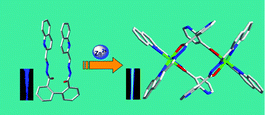Quinoline-based molecular clips for selective fluorescent detection of Zn2+†
Abstract
New selective Zn2+ fluorescent sensors, di(2-quinoline-carbaldehyde)-2,2′-bibenzoyl-hydrazone (QB1) and di(2-quinolinecarbaldehyde)-6,6′-dicarboxylic acid hydrazone-2,2′-bipyridine (QB2), have been designed and prepared. Both QB sensors exhibit an emission band centered at 405 nm (excitation at 350 nm) with low quantum yield. Zinc binding not only red-shifts the emission band to 500 nm, but also enhances the fluorescence intensity by an order of magnitude based on the deprotonization strategy via


 Please wait while we load your content...
Please wait while we load your content...